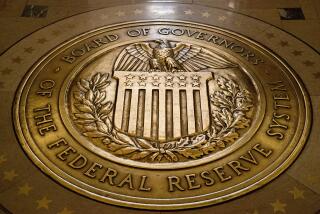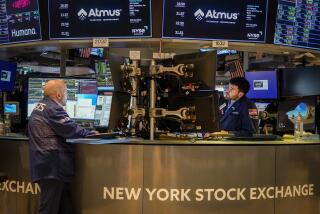With markets on edge, Fed takes urgent action to calm investors
The Federal Reserve took extraordinary steps Sunday to bolster investors’ shaken confidence, opening a lending window to securities firms, slicing a key interest rate and backing with $30 billion in emergency funds the bargain-basement purchase of ailing Bear Stearns Cos. by rival JPMorgan Chase & Co.
The rapid-fire announcements late in the day were timed to beat the opening of Asian financial markets and to assuage worries that investors, lenders and traders shell-shocked by the housing debacle and credit crunch would hunker down even more and drive markets lower.
In a sign of the high level of concern, Fed Chairman Ben S. Bernanke joined a telephone conference call with reporters Sunday -- a call that in itself was a break with tradition -- to announce the central bank’s moves. The most exceptional, the opening up of direct lending to major non-bank investment companies, required a vote Sunday by the Board of Governors confirming that “unusual and exigent circumstances” existed.
But the actions failed to stop the slide in the dollar, which plunged to a 12-year low of 96.75 Japanese yen in Asian trading late today, from 99.21 on Friday. Asian stock markets also tumbled, with the Nikkei-225 index in Tokyo closing down 3.7%. In Sunday’s hastily negotiated sale, once-vaunted Bear Stearns was valued at just $236 million, or a mere $2 a share -- 93% off its closing price Friday. Bear Stearns’ stock peaked at $170 early last year.
For Bear Stearns, a major force in sub-prime mortgage lending, the speed and ferocity of the fall underscored the depth of a crisis that threatens the financial system.
“It’s amazing that a firm with a storied history that has been respected for all these years has within two weeks literally gone from solvent to insolvent,” said Larry Tabb, head of a financial markets consulting firm in Westborough, Mass. “It’s scary and it’s horrible.”
Bear Stearns’ breakdown was in part a function of investors’ growing unwillingness to buy even high-quality mortgage-backed securities as the housing debacle worsened. That further depressed the value of mortgage bonds in recent weeks and triggered declines in other financial markets.
The Dow Jones industrial average has slumped 9.9% year to date, and at 11,951 on Friday was down 15.6% from its record high reached in October.
“This is a flight out of financial assets,” said Gary Schlossberg, senior economist at Wells Fargo & Co. in San Francisco.
The fate of Bear Stearns was sealed Friday, when it was forced to seek an emergency loan from the Fed after some of its customers withdrew money and its trading partners refused to do business with it, fearing the company couldn’t meet its obligations.
The last time the Fed made a loan under the authority it used on Friday was in the midst of the Great Depression.
Bear Stearns had reaped enormous profits during the housing boom by packaging mortgage loans into bonds and other securities that were sold to investors around the world. It came to symbolize the sub-prime mortgage crisis last summer, when two of its sub-prime-laden investment funds collapsed.
Nationwide, financial firms have written off more than $150 billion in sub-prime-related losses as mortgage delinquencies have rocketed, and experts have predicted the total could more than double in the next year.
Though it is far smaller than rivals such as Citigroup Inc., Bear Stearns is linked to its competitors through a web of securities trades and other transactions. Rival firms -- JPMorgan included -- could have been placed in jeopardy if Bear Stearns had been unable to make good on its commitments.
On Sunday, the two firms rushed to close the deal for fear that lack of confidence in Bear Stearns could infect other investment banks. “This transaction represents the best outcome for all of our constituencies based upon the current circumstances,” Alan Schwartz, Bear Stearns’ chief executive, said in a statement.
It was a stunning turn of events for Bear Stearns, which for many years enjoyed a reputation as a scrappy but cautiously run firm. It was headed for many years by the famed Alan “Ace” Greenberg and in recent years by his handpicked successor, James Cayne.
But although Bear Stearns appeared to have a rigid system of managing its risks, it was overinvested in the mortgage arena and failed to diversify either internationally or into other product lines as did its rivals, notably fellow bond powerhouse Lehman Bros. Holdings Inc. Top Bear Stearns executives received no bonuses last year. Cayne stepped down in January and was succeeded by Schwartz.
JPMorgan, which said in a statement that it was “guaranteeing the trading obligations” of Bear Stearns, has taken a much smaller sub-prime hit than most of its peers.
In a conference call with investors, Mike Cavanagh, JPMorgan’s finance chief, said the company expected the deal to boost its annual earnings by $1 billion even though it could incur about $6 billion in costs to unwind Bear Stearns’ losing trades and resolve its sea of sub-prime-related litigation.
Because of the Fed’s help -- it basically extinguished the loan it made to Bear Stearns on Friday and transferred it to JPMorgan as the firm’s intended buyer -- JPMorgan estimated it would only be exposed to about $13 billion of Bear’s roughly $33 billion in mortgage holdings.
“This is a good economic transaction,” Cavanagh said.
Among other things, JPMorgan gets Bear Stearns’ profitable business catering to hedge funds and a back-office operation processing securities trades for financial firms.
JPMorgan will exchange 0.05473 shares of its stock for each share of Bear Stearns. At Friday’s closing price for JPMorgan, that valued the deal at about $2 a share.
In Washington, the Fed sliced the interest rate on direct loans to commercial banks by a quarter-point to 3.25%. And in pulling the trigger on its emergency authority to lend to non-banks, it not only trod into terrain it hadn’t visited in three-quarters of a century but opened itself to the danger of having to make loans to other troubled investment companies or fire-sale purchasers.
Before acting it sought the blessing of Treasury Secretary Henry M. Paulson Jr. and the Bush administration. Paulson reacted by informing President Bush and saying that he appreciated “the additional actions taken this evening by the Federal Reserve to enhance the stability, liquidity and orderliness of our markets.”
Paulson was reportedly involved in the complex bargaining between the Fed board in Washington, the New York Fed branch, which is the central bank liaison to Wall Street, and JPMorgan’s top executives to consummate a deal for Bear’s purchase before the start of business today.
Fed officials said during the conference call that all five current Fed board members voted that the circumstances existed to trigger the central bank’s authority to loan to non-bank entities. The Fed almost always loans only to banks through its so-called discount window.
The new lending arrangement to so-called primary dealers, including key securities firms, will be slightly different from typical discount window operations with borrowers able to use high-grade mortgage-backed securities, among other financial instruments, as collateral for loans.
Although officials did not provide details, the arrangement’s aim, according to the Fed, was “to improve the ability of primary dealers to provide financing to participants in securitization markets.”
New York Fed President Timothy Geithner said on the conference call that the new lending was “designed to help get liquidity to where it can help play an appropriate role in [addressing] . . . challenges particularly facing asset-backed securities markets.”
The Fed is expected to cut the other major interest rate it controls by as much as a full point from 3% to 2% when its policymaking arm, the Federal Open Market Committee, meets Tuesday. Some analysts speculated Sunday night that the central bank might step up its decision to today if financial conditions don’t improve.
--
Times staff writer Tom Petruno in Los Angeles contributed to this report.






